B. Leaf Cronewrite and Drea Firewalker: Weaving Lesbian Community
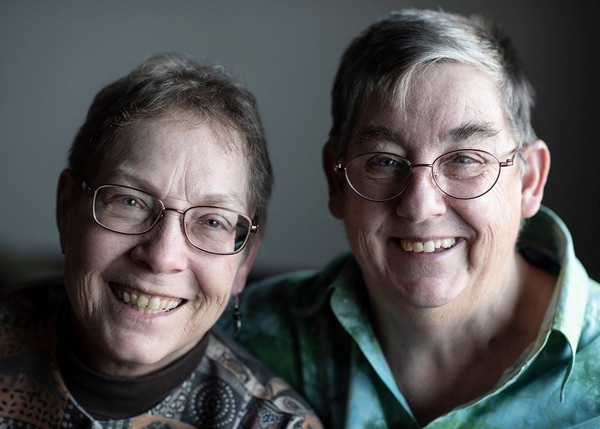
Interview with B. Leaf Cronewrite and Drea Firewalker by Merril Mushroom on Zoom, July 30, 2025.
Merril Mushroom’s July 30, 2025, interview with B. Leaf Cronewrite (also known as Mary Ann Hopper) and Drea Firewalker (also known as Andrea Nedelsky) focuses on their life together since they met in 1984. For background on Leaf and Drea before they met, see their individual interviews (July 15, 2025) on YouTube: Leaf, LINK Drea LINK (Transcripts of these will be posted soon.)
Meeting at Pete’s Bar in Kansas City
Drea (D:) Before we met, I was just out there in the bars, having fun, carrying on with life, just being a dyke-dyke. From the late ‘60s to early ‘80s, I had a lot of fun running in and out of different protest groups and political groups. Then along came this gal called Mary Ann Hopper…
Mary Ann (Leaf) Hopper (L:) Yay!!
D: …who would be the first of her type that I actually spent time talking to that I’ve met outside my group of tradeswomen.
L: My type? Right? Yes, The Academic. But I was tired of being an academic after teaching English in several colleges for twelve years. That’s why I moved to Kansas City, Missouri, because I was changing careers. I became a tech writer at Tallgrass Technologies, which was a company that created tape backup units for personal computers. Of course, I didn’t want to be a techie all the time. And I definitely didn’t want to grade papers anymore.
I had free time after work. I headed to downtown Kansas City, found the New Earth Bookstore, and talked to all the dykes there. I said, “Where do the women hang out?” They told me [to go to] Pete’s Pub. So that’s where I went, and Drea was the bouncer. I think she acted like I had to have an ID. She was engaging. Once I got there I couldn’t just mingle. She had to interrogate me. But she did have a cute little outfit on, one of those Michael Jackson outfits, a black and blue matching shirt and pants. I thought, at least, this one’s cute and wears nice clothes.
D: Yeah. And that was just the way we were. Pete’s Pub had a mix of blue collar and some professionals, but a lot of times the academic type, well they came in and they weren’t totally out. They were very cautious about coming in, so we would ask for phone numbers or to show us an ID, because police raids still happened at Pete’s. The police would just come in, turn the lights on, and check us all out. The academic types were a little more paranoid. My little crowd of friends tended to razz them. So, I always got phone numbers. That didn’t mean I used them right away. But I got phone numbers of the gals I liked, and I paid attention.
L: I was waiting for her to call. I came back a few times before she finally called. It took a while.
D: I was in no hurry.
L: She had other women there. I met some, too. I mean, I had my phone list too.
D: I know you did!
Working on the KCWSG
L: Anyway, the first thing that we really did together was the Kansas City Women’s Support Group, KCWSG. You were a part of that.
D: Yes, I was.L: You invited me to go to “a potluck” [comic emphasis], of course, to meet other women in town. That’s how I was introduced to the lesbian community in Kansas City, through the support group potluck. You had been a part of that for about a year, so I got to meet those women.
D: That potluck had come out of MCC [Metropolitan Community Church], where my friend was an assistant minister. They were going through their changes, but they had asked me if I’d take over this support group. I said, “Sure, why not? I’ll give it a try.” I didn’t know that much about it, but a potluck sounded good, and you know I had just discovered Spiral Dance, and I was actually forcing myself to read it.
L: We did realize we were reading the same book, Starhawk’s Spiral Dance. So that was a conversation we could have together about women’s spirituality as well as the lesbian scene. That was kind of a beginning conversation. She took over KCWSG as she often does in any group. Eventually, I got roped into helping organize it. I was a tech writer and had a computer, and was just learning how to do computer files then, in 1985.
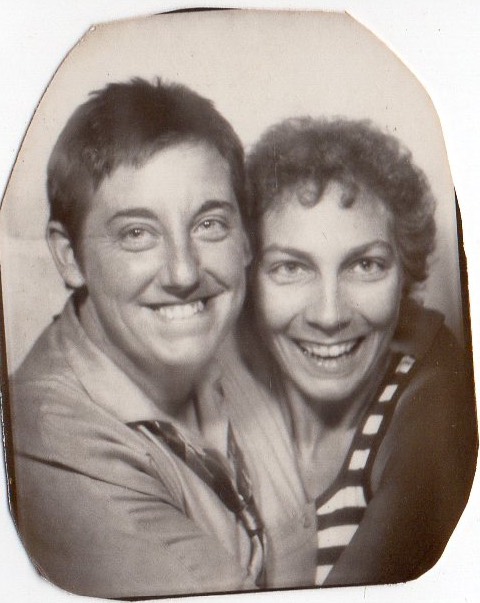
We started creating a newsletter. We gathered women’s addresses for mailing the newsletter so the potluck could be more organized. Drea would find different locations to meet. Then we’d have folding and mailing parties where we would get people together to send out the newsletter in the mail. I started typing up the newsletter every month and printing it out on a dot matrix printer, duplicating it at work to send out. That was our first little organizational effort together. Right? It was an interesting moment because I was not really wanting to get in a relationship. One of the things I was aware of was I never asked her what she did, because I didn’t like just talking about work.
D: She didn’t tell me she had been an English professor. She didn’t tell me she was well-educated. She talked more about her family, the little working-class family she had come from in Detroit. I think she must have recognized that I had an attitude towards educated people, and I did, for whatever it was worth. But that little bit, that made a big difference in how we clicked. Once I realized all these great skills she had, why not utilize them? It’s like, “You want to do a newsletter? I’m too insecure to do it, but you can do it. I’ll make sure we get together. I’ll make my friends show up.”
L: Since I left teaching at Tarkio College [a Presbyterian College in Tarkio, Missouri, 1883-1992], I decided when I came to Kansas City, I would introduce myself just as being new in town and working at a company in Lenexa, Kansas. I didn’t have to offer big credentials. For once in my life, I wasn’t hanging around with academics who always had to say where you got your degrees from and where you’re teaching and all the classes you’re teaching. I wasn’t having that kind of conversation anymore. I felt really kind of freed from it. Drea’s world was a whole different world from my world.
First Date
I remember our first date. Lord! I have a nice blue sweater on; she comes to the door in a Ghostbusters shirt. I’m thinking, this is a little weird. What kind of restaurant are we going to if she’s wearing a Ghostbusters shirt? We ended up at a Chinese restaurant. They don’t even serve drinks, because she’s afraid she’s going to have to pay for my dinner, and I’m going to run up a big liquor bill. I think, well, this is going to be kind of a cheap date. I paid for my own dinner. I hadn’t expected her to pay.
After the date, she’s driving around in this old Dodge Omni. Not a good choice in cars, so I’m thinking she knows nothing about cars. She decided to show me Kansas City. We drove by a million apartment buildings: “I manage this one. I know the owner of this one. Here’s the history of the Plaza upscale shopping district that I know about.” I got a real indoctrination of Kansas City in a whole different way than if I’d met some nice English teacher, and we had talked about the latest book that we read. It was kind of fun.
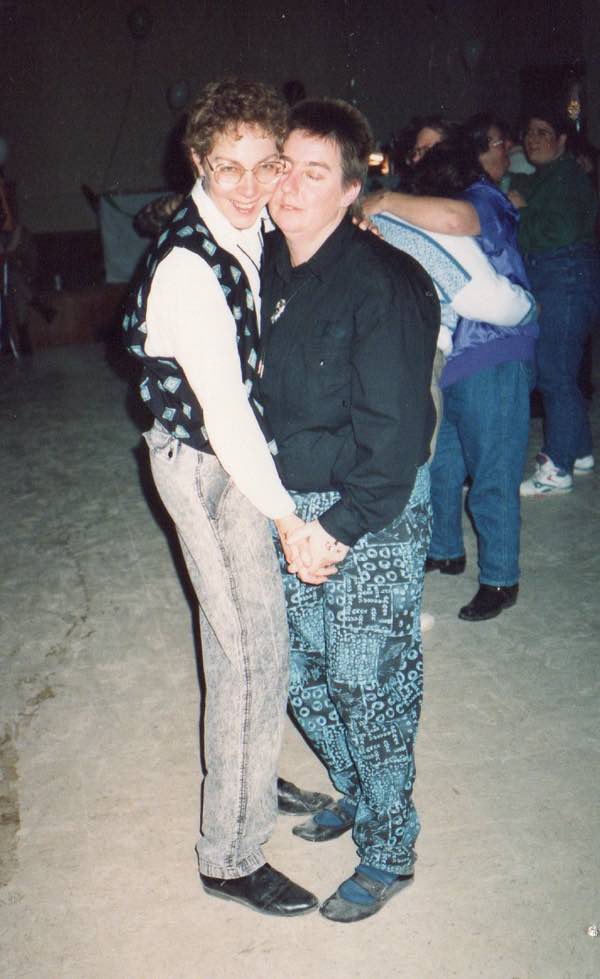
D: My world was a world of real estate, and I was glowing in the fact that I had discovered all these sources of money. I was running their businesses. I was bragging, basically, saying, “Hey, even though I might not sound educated or whatever, I am very astute about how the system works.” Then we ended up on top of a lookout point in Kansas City, overlooking the river, where…
L: Oh, that was romantic!
D: …the planes came in at the airport in the distance, and that’s where we had…
L: Then at least we could make a move. I thought, “Get on with it!” Yes, yes!
MM: Who made the first move?
L: I think we were kind of together on that since we were in the car. It was just like, “Isn’t this beautiful overlooking the Missouri River?” Lean, lean, we leaned at the right time…
D: I met her, let’s say, in August or September so it was six months before we really hooked up for a date.
Travelling Together
L: Yeah, that first bar meeting was in October [1984].
D: She had come to a number of potlucks with KCWSG; the group had already put on a retreat, a winter retreat or fall retreat, with about twenty dykes.
L: That I was not invited to, so I was a little ticked off at that.
D: Yeah, I did not invite her because these were all people I knew, and she’s just coming in. I wasn’t introducing her for them to think I’m with somebody yet.
L: Ha ha!
D: Leaf used to say that it takes every season before you get to know one another. I have to agree that that was probably a good line that she used. I was not in the position where I wanted to really commit to anybody at that point, as well as wanting to see how we got through three or four months together. I didn’t have an eight to five job. I worked whenever I needed money, like, when we planned to go to Michigan, our first trip.
L: Yeah, thinking about that first six months, even though you didn’t invite me to that February retreat, by summer I had already planned to go to MichFest [Michigan Womyn’s Music Festival]. I had been to it before, but she had never been. Drea had camping gear, I think, and I had a better car, so we decided our first real trip together would be MichFest. We would be on the road for a week or two from Kansas City, driving up to Michigan, so that would either break our relationship, because we got tired of each other, or it would make it.
We did very well on that first trip, and we were both introduced to the festival in a different way this time, as a couple. We went there together, but we were still free to go to different workshops, do our own thing. I don’t know if that’s the year we met Sonia Johnson. Probably her Wildfire book came out later [it came out in 1990]. It might have been then, yeah.
D: That was my first time going outside of the bar dyke scene, the Kansas City scene. That was my first introduction to the world of lesbians out there. It was one of those ‘aha’ moments that wouldn’t quit, and I probably rattled on forever. I went to lots of workshops and concerts, and I looked at everyone and the whole scene. I was like a kid in a candy store: “Oh, my gosh!”
L: And she took her shirt off!
D: Yeah, and I took my shirt off. We took pictures!
L: And I took my shirt off. We took pictures!
D: I couldn’t wait to take all the news back to Kansas City!
Bringing MichFest to Kansas City Dykes
L: We had a slideshow in Kansas City to try to educate these women to go to MichFest, and here we’re showing all these slides of all of us there, standing there without our shirts on, and they were going, “Whoa! This is one rowdy place!” It established our reputation as, you know, out of the norm.
D: This helped make that shift into the world of promoting lesbians and dykes and festivals and causes. It was just like a firestorm, because here I’ve been doing all this other stuff for women and for the gay, queer community. I was aware of prejudice against gays and lesbians, as in Anita Bryant’s anti-gay campaign in the ‘70s. Now I had a different focus. Sonia Johnson, her book about she/volution revolution triggered me. At MichFest I learned about all the landdyke things that Leaf knew about…
L: …because I knew Gail and Gwen [land dykes living in Mississippi]. Max Dashu might have been there with her film, https://www.youtube.com/@maxdashu/videos as well. I think that really prompted us to go look at women’s land. We thought we needed to be on women’s land, or we needed to buy something, or we needed to figure out how to get a women’s community together.
We started visiting. We went to D.O.E [Daughters of the Earth] farm in Wisconsin. We went to a lot of women’s land after MichFest. That was something we realized we had in common pretty quickly, wanting to figure out how to create more of a women’s community than just the KCWSG social group once a month. We wanted to live in it, like Sonia said, and have a community.
D: What was interesting is that Leaf knew how to find the places through Lesbian Connection (LC), advertisements, and talking with her friends, where I had the trade skills. We would go to those farms in different places. Of course, the thing I recognized was that a lot of women did not have practical building skills. They would just say, “We could really use you!” And I thought, “Yeah, I bet you could. But I’m not staying.” I was going back to the city. I like the city, and I had my own ideas going on. I was wanting to have an urban space for us to live and work in.
L: Right, because you had your house then. Drea was renovating her home at that time, the one on Harrison that was eventually part of Womontown. I lived in an apartment in Shawnee, Kansas. Her house was under construction. I did not want to live in construction, so she would come to the suburbs and stay with me. Then I would go into midtown on the weekends and help with the renovation project. I did learn a lot about these physical skills, using hammers and knocking out sheetrock, and going to hardware stores every Saturday. It was a new world for me, too; I hadn’t done that before. It was something new to learn. The idea of owning your own place and renovating it seemed good.
D: Yes, so we have now established, we were together…
L: …but we lived in separate places…
Meeting the Birth Families
D: Right. We’re doing our thing. But then it was time for holidays, time to start our first year of holidays together. Naïve Drea here says, “Sure, my family would love for you to come for Thanksgiving. Why not? They’re gonna get together and they know who I am.” So, we show up for Thanksgiving with my whole family there.
L: At your sister’s house in Indiana…
D: … only to discover that their ugly prejudice is about to show itself. Now I am very dykey looking, there is no question…
L: She wore a little tie.
D: …and Mary Ann, Leaf, comes in and, within twenty-four hours, we were asked to leave the family gathering because…
L …a lot of children were there. They worried.
D: They worried.
L: I think we spent one night at her house.
D: We did.
L: Then the next morning they had all talked.
D: They had decided to get together and turn on us and say, “We don’t want your type here. You’re welcome to stay, Drea. But y’all can’t stay as a couple. This is not good for the kids to be seeing what y’all are.” And it was like, “What the hell!” Here I’ve been out for twelve years plus…
L: …and they knew your other partner, Pat…
D: They had met my other partner, but I had never carried her home for holidays. It was kind of like, all right, we know, but we don’t want to see it. This was in their face, because I was making a commitment, and this was serious. At that point they gave us an ultimatum. They gave me an ultimatum. Leaf, Mary Ann, wasn’t there to hear the conversation. I was told either I choose my family, or I choose her. I said (sliding motion with hands) “Got it! We’re out of here. We’ll be gone by breakfast.” We packed up and left. It would be many years before we reconnected with the entire family, because this treatment was not going to happen again.
L: Yeah, this happened in Indianapolis. We had the entire drive home to Kansas City to discuss what this felt like, how we were going to deal with family. I wasn’t sure how she wanted to handle this, if I should back out, or whatever. I think it was on that drive that we really realized that we have to be number one for each other, and everybody else was going to be second. We were going to have to be the ones that are always sticking up for ourselves. I think it was on that particular trip we decided, the very same year we met, that we were committed, and we were. We were going to have to work at that.
Then, in December, I think, is when we went to Mississippi. We said, “Well, we’ll try it with my family then.” Because I’m an only child, Mom and Dad had already dealt with me coming out, and they weren’t happy about it back in 1977. But they were getting used to the idea that I was bringing some new woman around occasionally. So, we went home to Hernando [Mississippi] for Christmas with Mom and Dad.
We even went over to Corinth with Mom and Dad, where my dad’s family, a lot of his brothers and sisters, live and we often had meals over there. We have a picture of several aunts and uncles, Mom and Dad and us sitting around the dinner table. They didn’t quite know what to do about it, but it was like, if this is your friend, then she is welcome here. Their southern hospitality was on display. That worked out for our family because a number of times I would come home and check on Mom and Dad. We would also be going over to Corinth to see the other relatives, because I was close to a lot of my aunts and uncles and cousins over there. That bond, at least, was created.
Taking Care of Elderly Parents
L: I had elderly parents; my dad was developing Alzheimer’s. We were going to have to decide how to help them. Because I’m the only child, I have to help them out. They were in Hernando, Mississippi, which is close to Memphis, Tennessee. We actually talked about whether I was going to give up my Tallgrass job, move back near Memphis and get another job so that I could take care of them. And Drea was actually willing to move to Mississippi.
D: Well, I had a connection because I was in that circle of people that had money and owned a business. One person owned a cotton gin down there in Mississippi. I told Steve I might need a job, and he says “I’ll make sure you get a good position.” I told Mary Ann, we can go there. I know it’s outside my world, but I can go there, and I know I could work, and it’d be okay. If you need to take care of your family, we can figure it out. So, I was willing.
L: I think that helped cement our relationship, that she was actually willing to move to the South. I had just gotten into the tech world, and I didn’t really want to move back to Mississippi, so I asked Mom and Dad if they would be willing to move to Kansas City if we sold their house in Mississippi and bought another small house that we had found in Shawnee, Kansas, near the apartment where I lived. My mother was willing, and Dad wasn’t really making decisions then. We did sell their house, go there, pack them up, and drive the U-Haul truck home. Drea drove Daddy’s car, and he told her his entire life story all the way from Memphis to Kansas City, Missouri. I drove the U-Haul with Mom because it was a stick shift and it was hard to drive. We were together in that move. I think that that kind of cemented our bond as well.
D: Because of the type of work I did, I had flex hours for myself. I would take Mary Ann’s mom with me so she could get out of the house. She was a Northerner, and she liked the fact I was a Northerner.
L: Talk about Yankees together.
D: Yeah, it just gave her some type of comfort. She got to meet the folks that worked for me, who were a lot of trades guys or gals. She was sweet. She was tiny, so we called her Tiny. My dad was an only child, and he had passed away from alcoholism. His mother was still alive, and I pretty much became her caregiver during the same period of time. We never moved her to Kansas City, so I would go back and forth from Kansas City to outside of Joliet, Illinois, to take care of her. For the next number of years, in the late eighties, we were both caring for our elderly family during everything else we were doing with Womontown and KCWSG.
L: My dad passed away in 1988 during Drea’s house renovation. Mother stayed in the house in Shawnee. We had gotten pretty far along in our relationship, so I agreed to move to Midtown from the shiny suburbs. I didn’t want Mother to be in Midtown, too dangerous for her to be in Drea’s house alone while we were at work. Without Daddy to look after, she grew confused and eventually had dementia. It was a sad few years. She died in 1991.
Starting Womontown in Kansas City
Living in Midtown was scary because Drea’s neighborhood was still a blighted neighborhood. We’d sit out on the porch in the evenings, hearing gunfire, hearing the people next door throwing bottles at us and saying, “Dykes, you know you should move out of here.” That was kind of the beginning of us talking about Womontown.
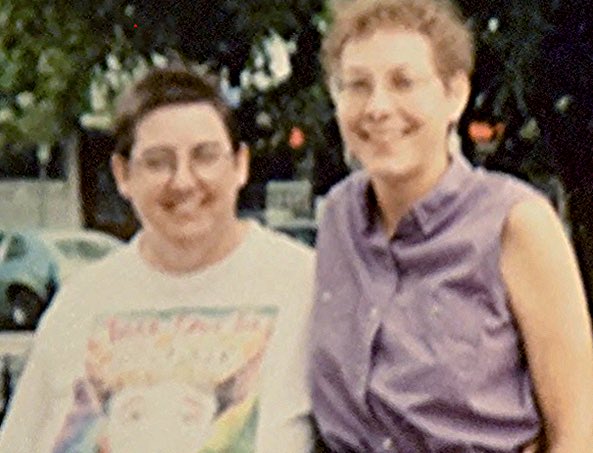
Wouldn’t it be nice if we got more friends to move here and create a real community here? We had still been talking at KCWSG about Sonia Johnson’s book and creating community. So that’s kind of what our motivation was for creating Womontown.
We put an ad about Womontown in Lesbian Connection (LC) and created a brochure. We decided to create a movement to encourage lesbians from all over the United States to move to our neighborhood and create a community. I had moved to a larger tech company by then. I had time to do my work and then switch my screen and type up response letters to our LC ad.
D: I was able to take my skills of managing all these other people’s properties and come into Womontown where there were a lot of apartments, and be able to offer to manage properties for free and find paying tenants. A number of the owners agreed, and we created a landlord association, and that helped us gain access to living spaces for the incoming lesbians. A number of them were slum landlords but I could get them paying tenants, so they were willing to evict a lot of low paying troublemakers from their buildings. That’s how we began handling this blighted area and holding off developers who wanted to destroy old buildings.
L: We decided to promote our movement by creating more connections with lesbian gatherings. Besides just the LC ad, we decided to go to the National Women’s Music Festival and do a workshop there to promote Womontown. That’s when it was held in Bloomington, Indiana.
D: That’s where we met Shewolf, who published Shewolf’s Directory of Wimmin’s Lands and Lesbian Communities [six issues, variously subtitled, 1994-2016). She got us connected with more people, like Brenda and Wanda Henson from Mississippi. [See the Hensons’ story in Sinister Wisdom 98, Fall 2015, pp. 142-45.]
L: We also went to the Midwest Womyn’s Festival in the Missouri Ozarks. Brenda and Wanda came up there from Mississippi. They were creating community down there. They had their social salon on the Gulf Coast then, and they were talking about what women’s community would be like and what they had already created. They were instrumental in inspiring us, too.
D: There was a lot of networking going on at the time, and we took full advantage of it, as well as being aware that it was different. The only model we had was what Sonia Johnson said we should try to do, and that was to take it block by block, house by house. I thought we could do that! If that side of me took over from the marketing and made it work and Leaf’s side of controlling the written word and getting it out there from any aspect possible, that’s how we could make it work. That’s how we were able to create this movement that has happened. Right?
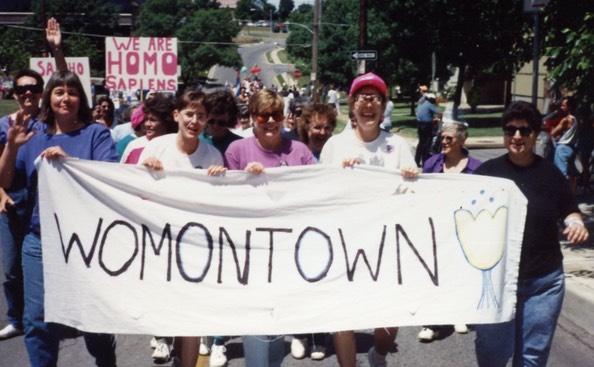
L: Right! I think your fortieth birthday was around, then? 1991. We went on an Olivia Cruise, our first Olivia Cruise and first time travelling with a bunch of Lesbians, for her to celebrate. We were also in Florida then. We went down to the Pagoda. We had to check in with that women’s group, too, to see what kind of community they were creating there. We were really on the lookout for models and connections. We met Marilyn Murphy and Irene Weiss there. We made a good connection with them. Not too long afterward they came to Womontown. We were trying to convince Marilyn to buy a house there, and she was really, really interested in one. But Irene was determined to go out to Arizona.
D: Yeah, she was going to Apache Junction. But we sure tried.
L: Yeah, we tried hard on that one.
D: Those connections became very important through the years. They helped get the word out. Marilyn even wrote about Womontown in her column in a California newspaper.
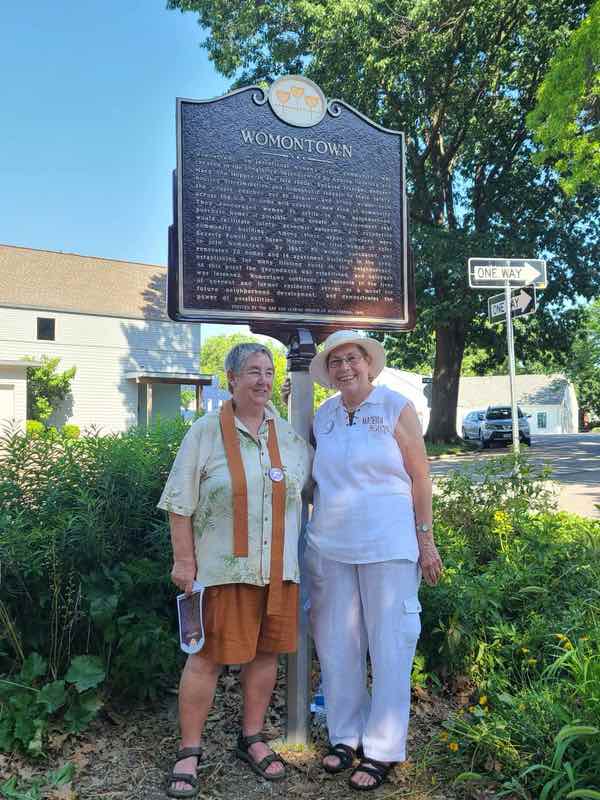
L: The rest of the story of Womontown is well-documented by the National PBS [Public Broadcasting Service] documentary on Womontown. There’ll be a link to Womontown on Youtube, so we won’t go into it a whole lot more. There is also a recap after the Womontown film[1] out there online. A year later the film was nominated for a Midwest Emmy. It didn’t win, but it was nominated, and we got to go to the fancy ceremony with the producers in St. Louis. That was a lot of fun. Last year there was a historic plaque erected in the middle of Womontown with a nice dedication ceremony. Our names and a herstory of Womontown are on that plaque. So many old friends came to the dedication. Over a hundred people from all over Kansas City attended. We were even interviewed by local TV stations for the evening news.
D: Our Womontown papers and pictures are in GLAMA, the Gay and Lesbian Archive of Mid-America at UMKC [University of Missouri–Kansas City], where I graduated from. Stuart Hines, director of GLAMA, welcomed our documents and helped get the Womontown plaque created. All these nice connections, through the many years that we lived in Kansas City together, had carried through.
L: We carried all of our Womontown documents and photos there so all of that is now stored at the University of Missouri, Kansas City.
Moving to Atlanta
L: After Womontown was underway in 1993, I was working for PARS, an airline reservation company that merged with Delta Airlines reservation service. The choice was, do I stay in Kansas City, because the company was moving everyone to Atlanta, Georgia? I went home and said, “Shall we stick with Womontown and keep this going? I can get another job somewhere else in Kansas City, or move to Atlanta.” I really didn’t expect her to want to move to Atlanta, because I thought, you know she’s a native of Kansas City.
D: I did agree to move, and I will tell you it was hard. I had a hard cry over it because we’d worked so hard. Just me living there and finding myself in my world, my friends, and so forth. I was now also about to leave a movement that we knew we had created and nourished and was standing on its own as well as could be. It was time for us to see where Mary Ann’s world was. I mean Kansas City was my world. The South was her world. We were about to move to Atlanta, Georgia, a whole different environment, though, thankfully, I didn’t have to move to Mississippi in the eighties. I was willing to say, “Okay, we can do this, right? Make the move.”
We actually did move in ‘93. For a number of years, I commuted back and forth to Kansas City, because I still managed a lot of the apartment buildings for these people, which was still my income.
L: We had rented our home to two lesbians for a number of years before we sold it to some gay guys, but we also owned an apartment building next door, and we had our apartment behind our building in Womontown. We were going back and forth, and really nurturing Womontown for the next ten to twenty years, so we never really left that community. Drea was there enough that many in the neighborhood didn’t even realize that she had moved.
D: It was so funny, because I’d hang out at the local Fric and Frack’s pub and people would say, “I haven’t seen you for a while.” Well, they were used to me because I had lived in Kansas City full time. I was part-time for about ten to fifteen years. I quit being part-time in Kansas City in 2015. Amazingly, that’s how long we were connected to Womontown.
We actually were part of the group that put on the spring fling,
down at the Atlanta Botanical Garden, along with a fashion show for the latest dyke look.
L: So, we moved to Atlanta and bought a contemporary house at the end of a cul-de-sac at the top of a hill to get away from everybody, but we did want to find other lesbians in Atlanta. Probably the first week or so that I was at work, a woman came over to my cube and said, “Maybe you would like to come to a women’s business meeting downtown called “4th Tuesday?” She and her partner were going to go, so that was enough of a hint for us to realize that this was a good entrance into finding women here. It was a lesbian business networking group, but it was also a social group that put on dances and a spring fling. Of course, we got involved very quickly in helping organize that…
D: At the point that we actually were part of the group that put on the spring fling, down at the Atlanta Botanical Garden, along with a fashion show for the latest dyke look.
L: We became involved in the women’s community here pretty quickly. We would go downtown a lot and try to find where the lesbians were. Their community wasn’t that organized in terms of an area. We thought about trying to create Womontown 2 down there, but it was a lot of energy, a lot of effort, and we didn’t have all the connections that we had in Kansas City. Instead, we just became part of a number of groups in Atlanta.
D: I was always going back to Kansas City. If her job didn’t work out in Atlanta, we still had the other home in Kansas City. I was always going back, anyway.
L: Well, you had a number of jobs there. When I moved here, the company moved me and they moved a lot of the people that I worked with. So, I had a work community of friends that Drea didn’t have. I realized that that made it harder for her, so she had to commute back and forth and do different kinds of jobs until she got into real estate here.
The very county that we lived in, Cobb County, passed an ordinance against gay families
D: At that point, I thought, all right. I’ll just go for it, get a full-time job in Georgia; I’ll just sell real estate. People called me Agent Andrea because I was going to be a different type of agent. I couldn’t get hired at first, because I didn’t fit in very well. I ended up in Cartersville, a more rural area north of Atlanta with some hippie friends that I met here. They said, “Come on, we’ll find you a chair in the office.” I will say, it was because I was an outsider in the rural area, that I was able to kick off my real estate world.
L: The local folks didn’t want other people in their business, so they were glad to have an outsider to help sell their house. You didn’t know Mama and Daddy and all their cousins that lived down the road. So yeah, the real estate business got her connected. Some of her realtor friends were always the most eccentric ones, the hippie folks. We had a lot of fun with them.
D: I know no stranger.
L: She knows no stranger.
D: If I sell to you, I love you, you love me. When Mary Ann turned fifty, one of my clients, who became one of my good friends, said, “Come on to Puerto Rico. Let’s celebrate.” I mean that’s the type of person I was, to be connected to anyone.
L: We did get involved in the Puerto Rican community. That was a lot of fun. We know her friend Sonia’s children to this day and still go to Puerto Rico to see them. They were very accepting of our relationship. Sonia was a very devout Christian woman who told her congregation off one time when they were speaking against homosexuals. We were very fortunate to have very loving and supportive, even straight, friends early on.
In ‘94, I think, the Olympics for 1996 were awarded to Atlanta so we were very excited about what was going to go on. There was a lot of renovation downtown. My company was going to be one of the sponsors, so we decided to volunteer. We got our uniforms.
Beforehand, though, we realized the very county that we lived in, Cobb County, passed an ordinance against gay families, and they decided that they didn’t want all these new people coming in from the Olympics, especially if they were gay. Family values were big in the early ‘90s. So, we ended up going to a march in downtown Marietta Square protesting that particular ordinance.
D: Here we are, coming from Kansas City, where we fight all of the systems and blight, and so forth. Now we’re out here in Marietta, Georgia, supposedly happy-go-lucky suburbia, only to find out that the pink triangle makes a good target for shooting our type of people. We are in the midst now, once again putting ourselves out there and saying, “We’re not going to put up with this, Cobb County.” They’re fighting each other, and we’re down there protesting with sniper police up on the buildings to protect us, and I’m thinking, good gosh!
Both: “What have we gotten ourselves into?” (in unison!)
D: It was very disappointing.
L: Yes, it was very disappointing. The result of our protest and many others, was, at least, that all the Olympic venues that were planned for Cobb County, that would have brought them tons of money, were pulled out. So, Cobb County got no money from the Olympics after all; it was all pushed back down to Fulton County and Atlanta. That made a difference. As time has gone by, Cobb County is now blue [Democratic], and a very different place. But in our early days here it was a worrisome place.
Travelling the World Together
In 1998, Drea met these women up in Cartersville, two dykes running a travel agency up north of here, and they were telling us about the Gay Olympics in Amsterdam. They said they could get us in with a group and we could go there. Then we became really interested in Gay Olympics. We thought about participating. But we hadn’t been overseas together so that was our first time planning to go to Europe.
D: Like that.
L: Yeah, like that. We went to the Gay Olympics in Amsterdam. We met a woman there who you ended up selling a house in Atlanta. Always connecting wherever we go! After that, we met enough people from Australia who said, “Well, we’re having the Gay Olympics in four years. Come down there.” Robin Tyler had a travel group back then in 2002 that went to the Gay Olympics in Sydney, Australia. So, we joined them. That was really fun. As a result, we kept thinking, we travel a lot; let’s do it with other women. It was a lot more fun. I found another travel group called Sights and Soul Travel. We’re still connected with them today. They’re a great travel group of women. They really got us on our trek of traveling the world, going to South Africa, going to China, going to Ireland.
D: B. Leaf, Mary Ann, retired in 2004. She retired because she could, and because we had done well enough in the world of real estate and…
L: …and there were transitions in the company. That was the buyout time: if you’re old, and you’ve been with the company long enough, we’ll give you a buyout if you’ll leave. I thought, well, we can leave. We’re in our fifties, and we’ve got lots more lesbians to find in the world. So now we’ll have more time to do it.
Attending, Then Producing, Womangathering
L:The one festival I’d been reading about in LC for the longest time was Womangathering that was held up near Scranton, Pennsylvania, in the Pocono Mountains. We said, well, now that we have time, this will be the summer to travel and find other women’s festivals.
D: Womongathering was a spinoff from Campfest that Lee Glanton had also created. She was a lesbian who wanted a spiritual side to a festival, a goddess side. I’m thinking of us going a full circle. Remember, we were reading Starhawk’s Spiral Dance when we first met in the ‘80s, so we were still interested in women’s spirituality. But we hadn’t done much with the spiritual side of goddesses.
We are writers. We are travelers, we are artists.
L: Sappho Morissette was there. She created a sacred fire and trained firekeepers at Womongathering. She was very engaging. Beverly Little Thunder created a sweat lodge. We didn’t know anybody when we got there, but we met lots of dykes, as usual. Dykes do all the work. They start things, and then some of the straight women come and join. They were mostly Wiccans and Pagans, also looking for a safe place. We met a lot of women and continue to be friends with some of them to this day. We had our croning there. I don’t know if it was that year, or a few years afterwards.
D: I was fifty-three.
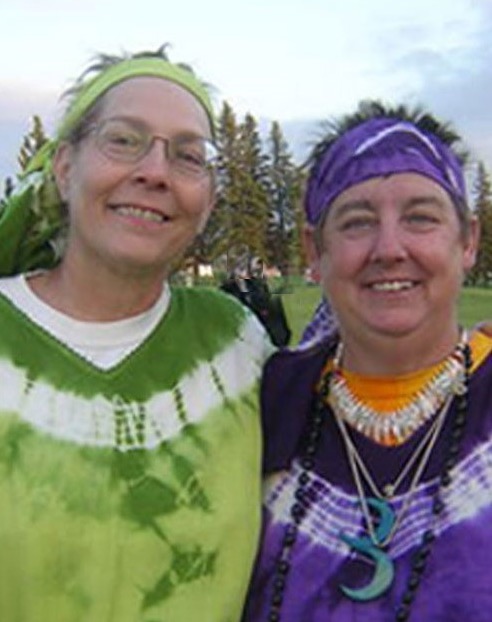
L: Yeah, we were introduced to what a croning ceremony was and about changing your name. We kind of needed a new definition. We didn’t really want to tell people, “Retired!” Because when people ask you if you’re retired, they want to know, retired from what? Then you have to recount your past history. So, it’s better to just say, “I’m recreating. And this is what I’m doing now.” We are writers. We are travelers, we are artists. That was our definition. I didn’t have to go through the tech world details. I didn’t need to talk about that, or the teaching world, anymore. That’s why the croning really made a difference to me. Changing my name was changing who I wanted to be, besides a career person, from then on in my fifties.
D: That’s when she became B. Leaf Cronewrite, and I became Drea Firewalker. That was in 2004. That’s when we embraced the new “us.” The new creation. We’re now going to be different in that regard.
L: We met Isadora Leidenfrost then, a young woman who had made a lot of interesting films. She had made a Green Tara film, then she was working on a Red Tent film. We were introduced to what a red tent really is because they had dedicated a whole building at Womangathering to the red tent. [The Red Tent concept is based on the book The Red Tent by Anita Diamant.]
By 2010, we actually ended up producing the Spirit of Womangathering, because Womongathering was dissolving, retiring out, and we said we could be a bridge, we could help keep it going. We chose to produce that particular festival all the way up in the northlands of the Pocono Mountains. With that came an even stronger emphasis on the red tent that we embraced.
L: Right. Yes, organizer Drea decided we could produce this festival for 300 or 400 women. Renting a camp is very expensive. We had spreadsheets and charts on all of our walls; there was a lot to organize. It was like Womontown, too, in terms of organizing. We organized for about six months. Fortunately, a lot of the women who’d been going to Womangathering were supportive and helped make it happen, because we really loved that festival.
We loved meeting the women there at Womangathering, a whole other culture in the northeast. The organizer was ready to let it go, and there was no one to step up. So, we did create a Spirit of Womangathering. Isadora Leidenfrost, our young friend, helped create a website for us and helped promote it. At that time, she was filming her movie, The Red Tent. She used that festival to interview a lot of the women for her movie. I’m even in a brief segment.
D: Which spring boarded us into a broader part of the goddess world, which resulted in us going to a women’s spiritual festival out in California, where we got to meet Z Budapest. Isadora was there showing her new film about Lydia Ruyle’s goddess banners. Beverly Little Thunder spoke at a session with other Native Americans.
L: Max Dashu was out there, too.
Attending Womonwrites
D: I feel like we have so many mentors. Even though we do our own thing, we hope we’re mentoring well enough. So many mentors have come through our lives from the time we met in ‘84 to today.
L: In 1997, after moving to Atlanta, I started going to Womonwrites, because I had always heard about it. When we were living in Kansas City, it was too far away. I realized that Gail (Atkins) and Gwen (Demeter) went to Womonwrites. It was a wonderful time to reconnect with them, and with you, Merril, and to meet all the other wonderful women that were part of Womonwrites.
D: That was the reason I’m bringing it up now. We were talking about producing events, and, at that time, during the 2000s, Womonwrites was needing money, so we decided to produce a fundraising event in Atlanta called Love, Laughter and MyTe Dykes at First E, the First Existentialist Congregation. We had a band and music, and we had a number of the Womonwriters read poems and stories and put on a real show. And I think it was near Valentine’s Day.
D: Yes, it was a Valentine Dance, too.
L: Of course, Drea sold ads to every realtor person she knew and gave them credit on the back of the program. She raised a bunch of money. I created the program. It was quite a big event, with over a hundred women. We raised money that we split with Charis Books and More in Atlanta. They got half of it and Womonwrites got the other half. That was another event to pull together a lot of different people that we began to meet in Atlanta.
D: Yeah. We’re always paying attention. Who’s needing some support? Can we be of some help? We’ve got a lot of skills between us, between my marketing and advertising side and Leaf’s writing and reading side. We do try to stay very current.
I had heard about Merril, you and many others over the years, but I’d never met any of you, because, again, we lived in Kansas City. When we came to Atlanta, it was like Leaf got her life back in that world of writers and friends. Leaf would go to the conference. It was seven or eight years before I showed up at Womonwrites, because it was a writer’s world, and that was her world. I got to go do my construction and property management. I’d go back to Kansas City while she was going to the conference, and it just really worked. One day, though, I was brave enough to show up.
L: You were! People didn’t think she was real, you know. But I’m glad you showed up.
The Crones Council and Other Community Activities
As a result of Womangathering, and then the Spirit of Womangathering that we produced, the festival eventually was taken over and continued by three other women, two lesbians and a straight woman, who really loved the festival. Then it was called Where Womyn Gather, which lasted a number of years more. We kept going to the festival and making connections until Covid. You were also leading croning ceremonies up there. After our croning, we took over a council at the festival called the Crones Council; that was kind of our role in that festival. Of course, we couldn’t just go as participants; we had to organize something! (Both chuckle) The Crones Council was needing a leader and we were willing to do that. You created a lot of croning ceremonies.
The whole croning aspect became more important to us as time went by. When we came back to Atlanta, we looked at our friends here, lesbians and some straight women that we knew from Unity Church, and said, “We see a lot of Crones here, and they’re not talking to each other. They don’t have a way to get together.” Therefore, we created a crone’s group here, a Crone’s Council, of our own. We decided to meet once a month.
We’d been living at that house on the hill for twenty years. We realized that we needed to get off the hill because it was very inaccessible for friends and for some of Drea’s family, for a number of folks that would come visit. It was a difficult place to get in and out because of all the stairs and steep, steep ground. So, we decided to move to where we are now, a ranch home, all one level, and create a women’s center, of course. (Laughter) We weren’t in a hurry to move from that house to this house. For a number of years this house was just a gathering place.
D: For four years we made this a women’s center, and we had lots of events going on here.
L: We did. We had a couple of weddings, a lesbian wedding.
D: We had an Art in the Garden festival. We had gallery art shows, a memorial…
L: …a memorial art show to commemorate our dear friend Barb Seegert.
D: Yeah, we did. Just whatever women wanted, we were available. It’s like, come on. We got this place…
We’re not joiners . . . but we always have fun.
L: …so many women talked about having a center. “If we just had somewhere to go; we could paint, we could teach.” We had a friend who did murals. I said, “Come over and paint on these walls and teach people how to do a mural.” We had a library of only feminist books, only women’s books. Friends contributed a lot of books. We were truly trying to get them focused on what it felt like to be in a women’s center…
D: We even set up a red tent in one room. There was a part of our group that was part of Compassionate Friends, women who had lost children to death. So, we were very, very aware of that. That was another small support group that came into our support center and the red tent could be a special grieving space.
L: About that time, I think, Isadora’s film, The Red Tent, was finished and she was traveling around the country promoting it. We said, well, of course we will organize an event for you. We decided to use the space at our Unity Church. That was a pretty liberal kind of group of people that didn’t know anything about red tents. We said, we can put a great fundraiser in here for Unity. You can make a little money, and we can have our friend Isadora come and show this movie. We got catering organized and put tables up in the basement after every church service selling tickets.
D: We had 250 women show up for that event.
L: Straight women, lesbians, whoever—but only women. The minister there was a guy that time. We said, “Your wife can come, but you can’t come.” It was a really successful event. As a result of that event, more people were interested in what the red tent was and the language of crones and goddesses.
D: Yes, and we are now even more focused on crone gatherings. What’s interesting is that we are not members of Unity. We go to Unity. That’s one of the things we recognized through our years. We do a lot of things because it’s our dream. It’s what we want to do. We don’t need to join and become members of somebody else’s project. We’ll support you. We’ll help out with whatever you need, but we recognize that we’re not joiners in the sense of, “We’re going to join and take a vow that we’ll be your member forever.” But we always have fun.
L: Well, we did realize about Womontown that it was our dream; it wasn’t other people’s dream. They would join and be a part of it, but it was our dream, which means we had the most energy, and we cared about it more than anyone else who came. They took advantage of it, they enjoyed it, they participated to the degree they wanted to. Everyone was free to do that, but to make it really happen and stay on top of things, it has to be your dream. We realized that, even when producing festivals, the festival in Pennsylvania. I mean, it was Lee’s dream when she started [Womangathering]. We enjoyed it, we loved it, we produced Womangathering one year, but it wasn’t totally our dream. We kept it going so that someone else who cared about it could take it on eventually, and they did.
The croning ceremony, though, became something important to us. It was our dream so we decided to create the crone’s group here after producing Spirit of Womongathering. In 2011, we started it. We now have about 125 on the mailing list for the crone’s group here. We meet once a month and have women talk about what’s important to them—not about their families, not about their grandchildren, not about other people. The focus is really all about them. During our last meeting, we talked about what each person is curious about, still, in old age. What are you doing that still excites you? A lot of people brought things: paintings, art, books, calligraphy, to show that women, even at an older age, still have a very vibrant life.
Djembe Drum Group and Drum Camp
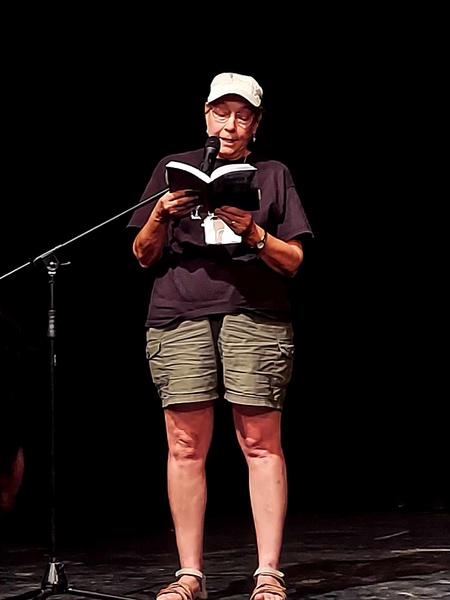
D: We don’t want to become invisible. The thing about both of us is that we recognize that we’re very out, out lesbians. It’s amazing how many people gravitate to us, which is great, but we want them to embrace the fact that we’re just dykes doing things we like with other women. It’s interesting to watch how they become more aware of other dykes coming out. The crone group is still going on today. We read different books. Some are Jean Shinoda Boland’s books: The Millionth Circle, Crones Don’t Whine, and Goddesses in Older Women. That one millionth circle concept? It’s just like, yeah, this is good. I mean the power…
L: …the power of women in circles, and the energy that can be created from that can expand into other kinds of circles, like our crone circle, even. Part of that expansion is the Djembe Drum group. We have a drum group now that’s met downstairs in our house most every Thursday for seven years. Because we create a place and we care about it, we can make sure it still happens. Women who care about it the most and are the most dedicated have been coming for those seven years. Others come and go. We invite anybody who wants to join, but once they realize the effort and the commitment to it, some stay and a lot drift on. We’re just aware of the things that we enjoy. We want to keep them going.
D: What it led to is, we discovered the Ontario Womyn’s Drum Camp up in Canada. This is our fourth year going. There were 250 women at the drum camp this year.
L: Lesbians started it twenty-five years ago.
D: They’re excited to see women, lesbians, from Atlanta drive that far, committed to go up there to do drumming and to be supported. They support us, we support them. In my world, it’s a full circle. Karen, who we met a couple of years ago, was up there this year. She saw our film Womontown in Paducah, Kentucky at Cinema Systers film fest, and she said, “Well, let’s get it shown over at London, Ontario.” So, we’re hoping to go if it’s shown in London, Ontario, Canada. When we do, we hope the drum women from Canada come over to watch it.
L: Drea is trying to organize, of course.
D: Of course.
L: Yes, there is a lesbian film festival in London, Ontario, that’s been going on for quite a while. Barb van Helsdingen has gone to it a number of times, and she asked if Womontown was playing there yet. So, we have a connection there. We hope we get the film shown there.
The Ontario women’s drum camp has been fun. We’ve met a lot of wonderful dykes, mostly from Canada and Michigan. Now we feel like we’re really a part of it again, a part of a different community. You have to go for a few years for women to see you, recognize you, and realize that you really care about what they care about. We’ve had fun with that. On the way home this year we visited Lisa Levart in New York, who is a wonderful artist. We met her at Womangathering years ago. She has created…
D: …“Goddesses on Earth!”
L: “Goddesses on Earth,” a film about women embodying the goddess spirit of different characteristics. She takes portraits of women in their power and has created a wonderful art book. She made a film about her artwork, and we, of course, produced it here at Unity Church so she could come down. We’re trying to create women’s community, even for her, in a different environment.
D: Supportive? Right?
L: Yes, yes!
D: Right. We just keep our ears open to what’s out there. What’s next. Like right now? The big movement. There are two movements going on. One, the lesbian bars are disappearing. So, we have been going to different ones around the country to visit them.
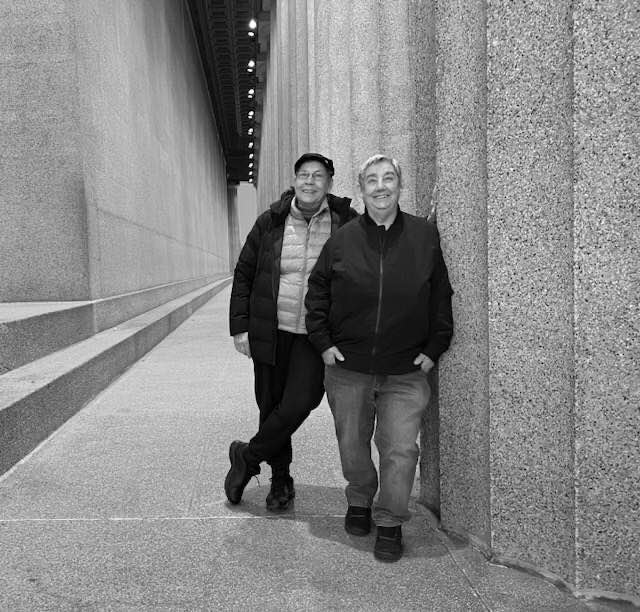
L: Women’s sports bars, too —
D: We go in, we say, “Hey! We’re from Atlanta, and we’re here to support you,” which is always fun. The other [movement] is the sports bars that are opening up, the women’s sports bars. We are making a point of going to those. These are young forty-year-old, thirty-year old women starting these businesses. It’s different from the bar dykes that we knew in the ‘60s, 70s, and ‘80s, where we were in the back rooms, you know, or back alleys, going to these bars and needing police protection. These sports bars are in fun little funky areas. We have one here that just opened recently. We went to the grand opening of “Jolene, Jolene,” and yay for them! Then we tell the dykes, “Go support it. Go be part of it.”
L: Yeah, we’re happy to hear that they’re networking a lot and we’re promoting them wherever we hear about them. Yeah, we’re finding the owners of them, we’re going there, we’re saying, “This is who we are, this is what we’ve done. We’re proud of you!” We tell them, “We’re proud of you! Just keep it up!”
It’s a different culture. You know, it’s not just all lesbians in those bars, but the majority are. When we walk in, it’s like, oh yeah, this still feels like home, it still feels like an easy connection, talking to the young women and seeing what’s going on in their worlds.
Getting Married
Oh, we forgot that we got married. This year we visited Celia up in Northampton. That’s where we got married, at Smith College in 2009. We wanted to go back to Smith to see the spot in the garden where we got married so Celia took us out there. We went to the very little fountain where we had gotten married. It was nostalgic.
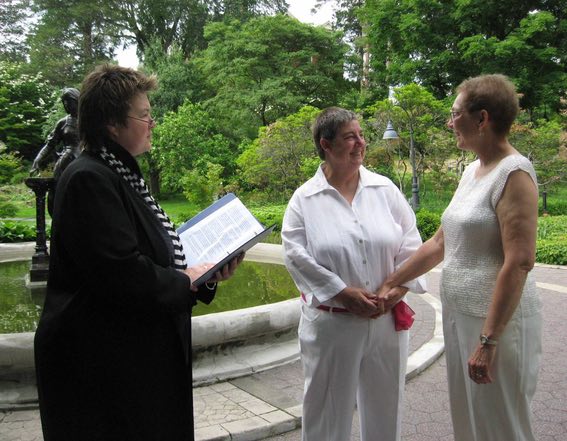
D: We’d been together twenty-five years—
L: Yeah, by then. Yeah. By then we were definitely committed.
D:… committed enough, maybe we should get married. So, we went to Massachusetts in 2009 and got married legally, and then we came back here to Atlanta, and threw a big twenty-fifth anniversary party at …
L: …Callanwolde Fine Arts Center.
D: We rented the whole place. It was a wonderful celebration. Sue Barbara videoed it for us. Lots of the Womonwriters showed up and read special writings. Goddess friends from Womongathering came…
L: …came down from New Jersey. Even my Southern cousins came. Drea’s sister and…
D: …by now…
L: …two good sisters…
D: I do have a big family, but out of it only two sisters and their families were supportive of us. They show up. When we put on the actual event, our circles are filling up with our life of togetherness, because of how we’ve journeyed together. It really showed in this…
L: …in that anniversary party. Yeah. So many people together that would have never known each other in any other life.
D: We even had people calling the directions and people serving wine and snacks. It was what it was.
L: People read and sang, and we had a big circle.
D: Anyway, now it’s 2025.
L: Forty years together.
D: Yeah, forty years later, still very independent, very together. I’m still doing my artwork and doing my thing. Leaf still does her…
L: …still writing…
D: …her books. Yet we are still out there with the lesbians, young dykes, and so forth.
L: Whenever we cross their paths…
D: …we just keep encouraging them.
Leaf’s Writing
L: Andrea [Drea] was very supportive of this. I had written so many different short stories. Her friend Larry—a musician as well as a realtor—found this recording studio in downtown Atlanta. He said to check it out; they encourage young people to come and record on the studio’s off times, when famous singers aren’t there.
I went to this professional studio called Patchworks with six of my stories. I didn’t have to pay a lot of money, really, but got a professional studio with a sound mixer and an editor and everything, to record my first CD of my collection of Southern short stories called Missing the Magnolias. It was a very exciting environment to get to do it in that studio. They’re very professional. Even though I was having to work with guys, they didn’t care that I was a dyke. They were all about the professionalism of it.
Once I made the CD and put it together as a collection, I thought, well, I can publish a book, another collection of short stories, Don’t Let the Flies In. I’ve created all these characters. Some of these characters grew out of going to art festivals where Drea was selling bird baths and bird feeders and bird houses. I would start listening to people at these art festivals, listening to their dialogue, listening to their lives. Some of them inspired some of my stories. I mean Eudora Welty always used to say that she listened to people talk and got a feel for what their lives were like. So, Edith and all of her buddies in Don’t Let the Flies In were the result of overhearing folks in other booths selling their wares at the arts festivals.
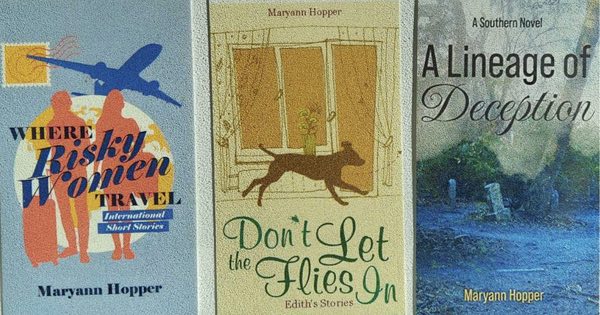
My next novel was full of Southern stories. I began to think about Edith’s friends. I wondered who all of her neighbors were, so I created a number of stories and all these people showed up, two sisters, two daughters, an adopted child, wayward husbands. They all filled up chapters that ended up being my novel, A Lineage of Deception.
The next book was Where Risky Women Travel. Because we’ve traveled so many places, I had decided that instead of just writing a memoir about my travel, I would create two fictional lesbian characters: a photographer and a gallery owner. The photographer wanted to shoot all these exotic pictures and be rebellious, so she went to some of the places that we’ve been: China, Africa, Peru…
D: …forty-two countries later— (points to Leaf with a smile)
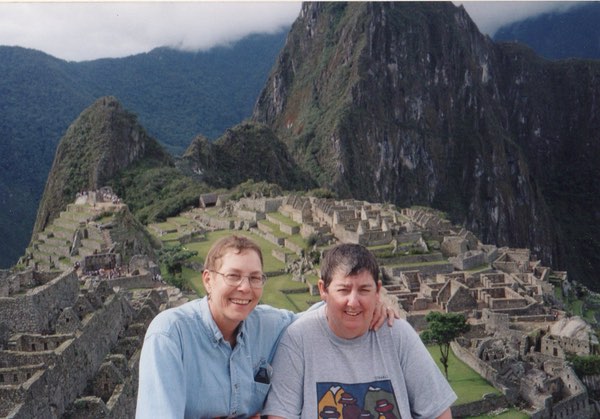
L: There are only a few trips there. Machu Picchu, Galapagos. Writing the last book, Where Risky Women Travel, was fun to remember and include some of the places we had been. The second section of stories in Risky Women explores the relationship of two lesbians from New Orleans searching for a lost grandmother and struggling with their own waning relationship as they travel in New Brunswick, Canada. It is such interesting countryside up there, including the Bay of Fundy, so I had to get them there.
The one I’m working on now is Tiffany, a young adult novel. Tiffany was introduced in A Lineage of Deception as an adopted girl, so I tried to imagine the life of a young, adopted girl, from her point of view, searching for her real family. That one should be out early next year. The Hippie Farm, about all those folks that live at a hippie commune named the Roost, will be coming out after that. Those have been my writing adventures for the last ten years or so.
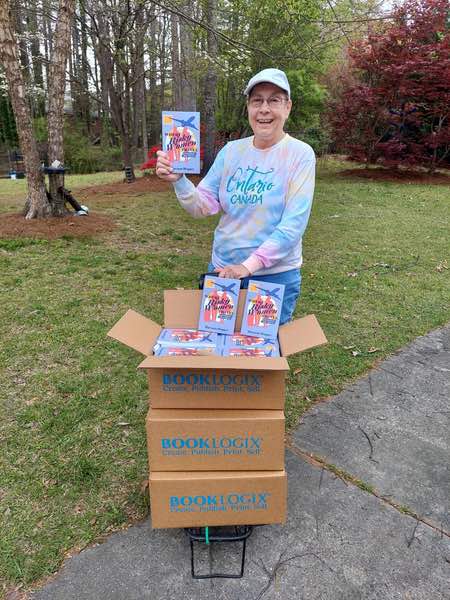
Drea’s Glass Art
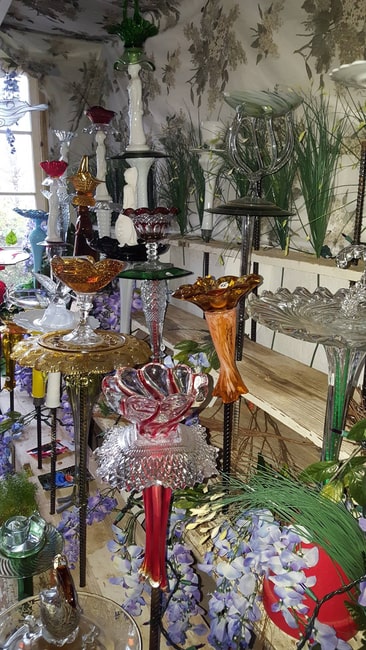
D: That’s how Leaf has recreated herself, by being an author and novelist. I love it because, when you say she’s an author, people go, “Oooo!” It is kind of fun to watch. I recreated myself, too. I still do my real estate because I love real estate, but I recreated myself in the world of blown glass and glass objects. I create bird feeders, one of a kind, by fusing high end and antique glass pieces.
I’m a Chihulaholic. I follow Dale Chihuly’s work. I got the opportunity to meet Chihuly. He kind of said blessings to the type of glasswork I do. I’ve done a number of art festivals around the country, several in Cedar Key, Florida, where I won awards. Also, in Atlanta I’ve won awards for the type of work I do. It keeps my creativity going, between that and the croning rituals that I still do today. Our last big croning was last year, which we did for the seventyish age group.
L: …also honoring our elders, because there are a number of women over eighty in our crone group as well. Lots of good wisdom there.
D: That’s who we are today. We appreciate all that we know, what all of y’all have done before us. We’re very grateful for this opportunity to share our life and how we are.
L: We love road trips, so no telling when we’ll show up at your place!
D: I know it. We tried. We just missed you, Merril, by a moment, but we did get to the Bar Dyke play. [A play written by Merril Mushroom, set in the 1920s. It was performed in Los Angeles and Florida in the 1980s. Later, they revived and performed the play in New York City; in Los Angeles, California; and in Massachusetts. Most recently it was performed at the Chinkapin Theatre Arts in Woodbury, Tennessee.] We’re always looking.
MM: You want to say something about your memorial project at Womonwrites?
D: Yeah, that is part of who I am as a person. I’m very psychic-driven, thanks to my grandmother, who encouraged that side of me. At Womonwrites, even though I didn’t know a lot of the women, I felt their spirits there on the land at Indian Springs. I felt very, very humbled by being able to do several special memorials for them, calling them forth, knowing that they had been among y’all, and had such influence on so many. It still resonates with me today, honoring the Womonwriters that had passed away. I still think of many of them.
When Salamander and Barb Esrig passed away [See She Who Will Be Remembered on this website], we did a memorial at Dykewriters conference in 2024. We actually did a memorial to those that we know in our circles that are passing away. I still am very honored to be able to set up rituals that say, “Here’s who we are, who we still are, even though we’ve passed from this life to the next.” I feel that is part of who I am. Even today, I’m still doing ritual services.
L: She adds a lot to the Dykewriters’ conference by bringing art and creativity and a spiritual aspect to the gatherings. She’s creating kind of a meditative space for writer
to think about their art and their writing as well and be inspired.
See also:
“Womontown: How 12 city blocks in Kansas City became a radical enclave by and for women,”
Books by Mary Ann Hopper on Goodreads and Amazon
